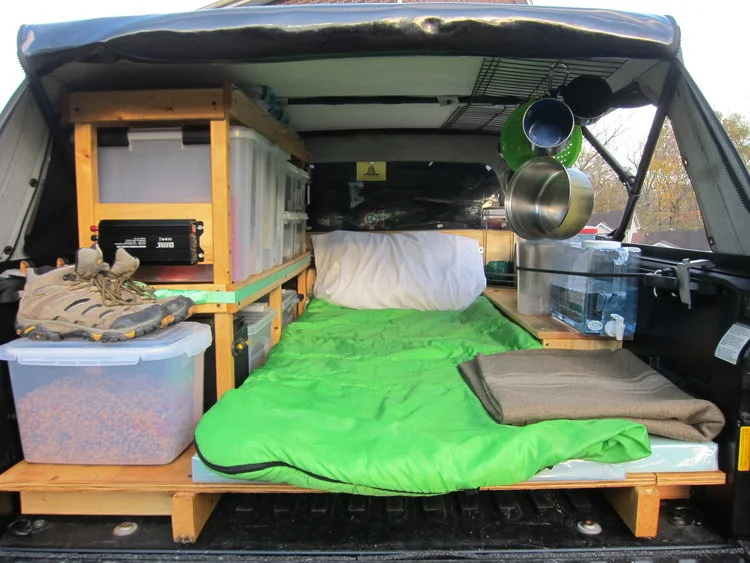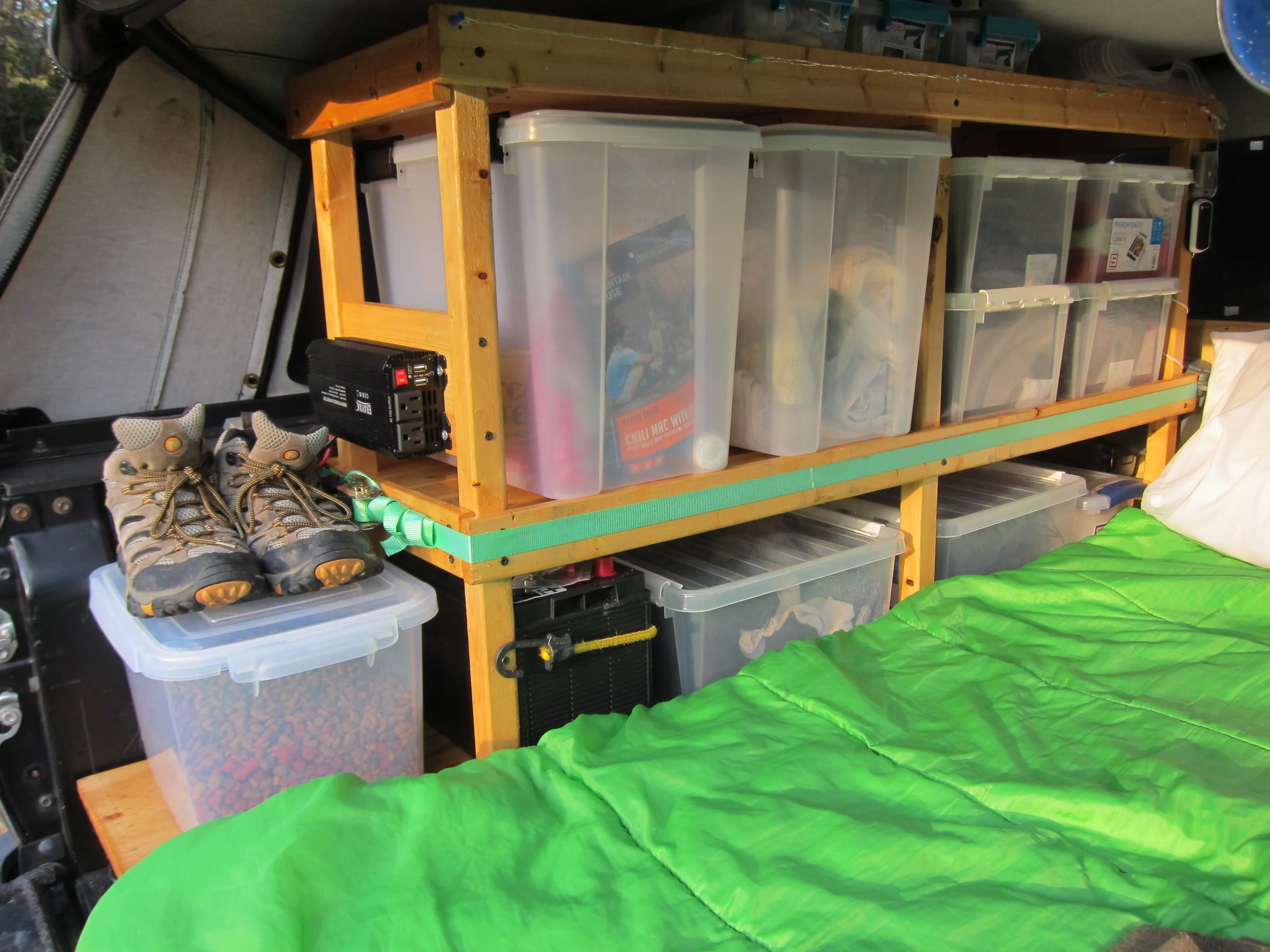Three months ago, I started daydreaming about how one might (in theory) travel across the country in the dead of winter on a budget. After a quick exercise in number crunching, the results didn’t look promising. At that time, I didn’t have a ton of money saved up, which was a problem because conventional wisdom would have you believe that traveling is expensive. From past experience, however, I’ve found that traveling is only as expensive as you allow it to be - the key is to be mindful from the beginning of what expenses you can and cannot live without.
So after that initial budgeting exercise, I determined that the only way I would be able to make this trip a reality would be to cut out the biggest expense of all - lodging. As someone who camps frequently, that seemed like it could be a reasonable compromise - if I was planning this trip for, say, March or October. Unfortunately though, fate handed me this opportunity with one big, damp, bone-chilling caveat - I will have to do it during the three coldest and wettest months of the year.
SPRING BREAK!!! WOOOOOOOO!!!
(Source)
So how was I going to plan for a low-budget road trip, through some of the chilliest places in the US during the chilliest time of year without chilly-ing myself (and my dog) to death?
I got creative and got to work.
Now, here it is, two weeks to the day from my departure date and I have the answer (or, at least, a rough draft of the answer).
In addition to crashing on the spare beds, sofas and floors of friends, I decided to solve the cheap lodging problem by turning the back of my truck into a mini-camper, with just enough room for me, Gabby and all the day-to-day supplies I would need for +/-3 months on the road. Fortunately, there's no shortage of ideas on the internet for how to affordably “build out” a truck bed for cold weather camping.
21,900,000 ideas, to be exact.
(Source: The Google)
As it turns out, vehicle build-outs are a popular project for skiers and rock climbers, two groups accustomed to cold-weather excursions to the middle of nowhere on a budget (I learned some absolutely brilliant tips and tricks from a ski bum forum that I hope to share in a future post). If these guys can survive below-freezing temperatures in a ’94 Honda Civic with a space blanket glued to the roof, surely I can figure out how to do it in the back of my truck.
So, with plenty of precedent imagery at my disposal, I set out to build my very own truck bed camper.
Behold!
After two and a half months of trial and error, this is my finished setup. It hasn’t been cold-tested as much as I’d like (80° and sunny in November!? Get it together Tennessee) but it should do the trick.
Disclaimer: For the handful of people who are reading this and want to know about the nuts and bolts of putting it all together, this next part is for you. For everyone else, feel free to skip ahead to the end.
The Bones
Working from the bed frame up, the most important consideration during this whole process was how to minimize contact between the wood frame and any water that might find its way into the truck bed - the fabric camper shell isn’t 100% watertight at its base. So I started by creating a raised platform from a piece of 15/32” 5-ply plywood over a frame of 2x4s, with each 2x4 spaced to sit directly above the drainage channels built into the truck bed. The benefit there is three-fold - first, it allows water to move unimpeded below the platform; second, it creates an air pocket so that the metal frame of the truck doesn’t sap the warmth of the bedding above it and third, it creates a space for Gabby’s collapsed crate below, along with some other odds and ends such as jumper cables and bungee cords.
You can practically smell the polyurethane.
The shelves are adapted from a set I originally built to sit on my desk at work, so they’ve already been strength-tested against the crushing weight of numerous plants and landscape architecture reference books. A few adjustments were necessary to make them fit within the awkwardly-shaped truck bed but, overall, they've worked out well. In fact, it was these shelves that inspired me to try the camper conversion idea in the first place, one day while my mind was wandering at the office.
Both the platform and the shelves, as well as the little bench over the passenger-side wheel well, are isolated from the bed of the truck by a quarter inch gap to allow any water that might flow in from cracks around the camper shell to pass harmlessly down to the bed frame below and out through several drainage holes.
Finally, as a last resort against drips, drops and drool (looking at you, Gabby), I’ve coated all of the wood components with a thick coat of Helmsman Spar Urethane. Judging by the lingering smell, possibly too thick of a coat.
Storage
Because every square inch of space is going to count, I had to maximize my storage solutions.
Enter…The Container Store.
Which is, itself, just one big container. Meta.
(Source)
I have to tell you, this place made it all possible. It is simultaneously the most wondrous/depressing store I’ve ever had the privilege/misfortune of visiting. Giddy housewives dragging their dead-eyed husbands back and forth through aisle after aisle of containers in every size, shape and color imaginable - and then there’s me, crouched in a corner amongst a pile of seemingly identical clear plastic bins with tape measurer in hand, muttering to myself about the tradeoffs of height versus width. I am uncomfortable with the number of times I visited that store over a one month period.
Seriously though, container selection was a BIG deal. Not only did they have to be the right size but they needed to be odor/watertight, freeze-resistant and clear (to discourage theft, at least in theory). As someone with a penchant for organization, I can say there was something oddly comforting about downsizing my whole life into a bunch of containers and being surrounded by them as I sleep.
Staying Warm
Because we've had an unseasonably warm fall this year, all of my cold weather planning has had to remain in the realm of the theoretical. Which is too bad, really, because I'd sure like to know if the setup I put together during those 80° Nashville afternoons will also work during those -10° Minneapolis nights. Only one way to find out!
I plan on doing a separate post later on the subject of staying (or attempting to stay) warm, so I won't go into all the details here. Worth noting, though, is what I like to call...PLAN B.
Tucked up under the shelves on the driver-side is a deep cycle marine battery for use in emergencies (the "b" is for "battery," get it?). While it wouldn't be safe to run a heater all night for a number of reasons, this battery should allow me to run a heater, laptop, phone charger, etc. for several hours in the event of an emergency and, as the "deep cycle" part of the name suggests, it can be drained lower and recharged more frequently than a typical car battery.
Next is the workhorse of the cold-weather preparation gear: the tried and true Italian wool blanket (or rather, the stateside knock-off for us budget-conscious types). Throw it over a couple of sleeping bags and a snoozing dog and you should be good well into subzero temperatures.
Finally, for the bottommost insulating later, I'm using a 2" open cell lux foam pad, cut to fit (6' long by 33" wide). I've been sleeping on this pad for about a month now and I feel more rested than I ever did with a traditional mattress. In order to guarantee that it stays dry, the pad is wrapped and sealed with a shower curtain liner, which can be replaced as needed.
Getting up in the mornings is going to be rough, no doubt there, but that's all part of the cold weather camping experience. Once the coffee pot starts bubbling and the smell of bacon hits you, you forget all about the night before.
What started out as a daydream is now a finished and fully-functional camper. A lot of frustration and head-scratching went into its design, construction and testing but, overall, I don't think I could be more pleased with how it turned out. The question, however, still remains: will it work? Time will tell.
So that's it, then. With the exception of a few minor things remaining on the to-do list, all I can do now is wait patiently and try not to have a panic attack every day. But hey, at least the weather's nice.
CWO









